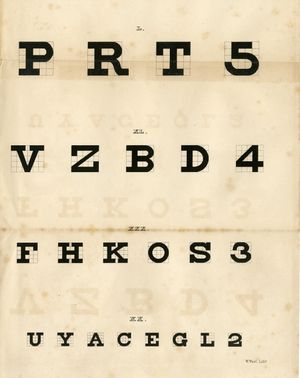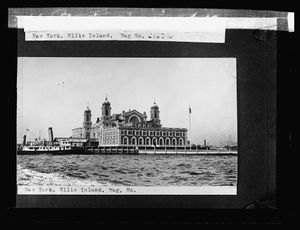Author: Aubrey Minshew, Museum Specialist, Truhlsen - Marmor Museum of the Eye®
If you visited the museum this summer, you may have seen a display case of historic eye charts and vision tests, a part of our year-long display series of eyeglasses, vision aids, and vision tests complimenting Spectacular Spectacles. In this display, the modern eyechart was almost instantly recognizable, but it also featured some lesser-known eye charts that might not look so familiar. One set of vision tests in this display tells us a great deal about the history of immigration to the United States and gives us an interesting behind-the-scenes peek at how museum collections and exhibits operate.

Eye charts on display in the museum
The objects I’m referring to are a set of four small vision charts printed in different alphabets, including two sets of symbols, one in an older German-style script, and one in the Hebrew alphabet. These charts all featured carefully designed “optotypes” or letters specifically sized and placed for determining visual acuity. These eyecharts, like the ones we use today, were descended from the work of Herman Snellen (1834-1908), a Dutch ophthalmologist, who developed the modern seeing eye chart in 1862. Of the many innovations that Snellen made in visual acuity testing, a major change was basing his optotypes on a specific external standard (a 5-inch arc) that others could adopt to create accurate standard eye charts.

Early Snellen optotype designs
Snellen’s visual acuity tests became widespread just before a period of unprecedented immigration to the United States. In 1891, less than thirty years after Snellen published his work on optotypes, the best-known immigration station in America, Ellis Island, opened. In 1897 the United States government categorized trachoma, an eye infection, as a “loathsome or contagious disease” that required screening. At the same time, the U.S. Public Health Service wanted to filter out immigrants who were blind or had low vision because they were perceived as being likely to become wards of the state. To do their work, eyecharts were printed in the common languages of immigrants to the U.S. Charts were also printed using symbols or “tumbling Es” to test immigrants who either didn’t speak English or couldn’t read at all. Between 1891 and 1930, nearly 80,000 immigrants, or 1% of those seeking entry, were barred from the U.S. for medical reasons including trachoma and low vision.
Practical Treatise on Diseases of the Eye, 1820
If you visit the National Museum of Immigration at Ellis Island in New York Harbor, you will see eye charts on exhibit and you might think that they look very similar to the ones on display at the Museum of the Eye. You’d be right to think that, because actually they’re on loan from us! Our collection contains a set of thirteen separate eye charts, three of which are on loan to Ellis Island. Our relationship with the Immigration Museum began in 1988. The only significant time our eye charts weren't on display was for seven months after the devastation of Hurricane Sandy which created a destructive tidal surge in New York Harbor. When the museum was ready, the Museum of the Eye was more than happy to lend the charts back to Ellis Island.
Ellis Island in New York Harbor
Behind the scenes, it is very common for museums to loan objects to one another for specific exhibits, but loans are a complicated legal and logistical process. Agreements need to be drawn up for all sorts of details, like the term of the loan, or who is going to provide insurance or care for the object while it’s away from its home institution. Stipulations must also be made for physically moving the object from its home museum to the borrowing museum. With an object like the museum’s eyecharts, this process is relatively simple, but imagine how complicated it must be to loan large objects, like large sculptures in art museums, or even retired military planes for an air and space museum. During my career, I have witnessed the latter in person. When a non-functional airplane was requested on loan, both institutions worked together to carefully move the plane through a complicated system of container ships, trucks, and finally installation in a building whose walls rolled up like a classroom map. Quite an experience!

Modern Ellis Island and the National Museum of Immigration
So, the next time you visit the Museum of the Eye, remember that small historical artifacts like eyecharts often unlock a much larger story that you might not expect. Also, when visiting any museum, consider how many exhibits are a mixture of objects from different museums and owners and what a complicated logistical system had to be developed behind the scenes to create the show that you’re enjoying.